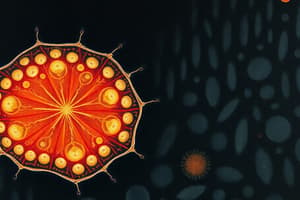Podcast
Questions and Answers
What is the simplest level of organization in the human body?
What is the simplest level of organization in the human body?
- Tissue Level
- Organelle Level
- Cellular Level
- Chemical Level (correct)
Which organelle is responsible for energy production within a cell?
Which organelle is responsible for energy production within a cell?
- Nucleus
- Ribosome
- Mitochondria (correct)
- Golgi apparatus
What range does the pH of human blood need to maintain for homeostasis?
What range does the pH of human blood need to maintain for homeostasis?
- 7.50 to 8.00
- 6.00 to 6.50
- 7.35 to 7.45 (correct)
- 7.00 to 7.30
At which level do different tissues work together to perform specific functions?
At which level do different tissues work together to perform specific functions?
What is the importance of acid-base balance in the human body?
What is the importance of acid-base balance in the human body?
What effect does an increase in temperature have on the speed of simple diffusion?
What effect does an increase in temperature have on the speed of simple diffusion?
Which of the following statements about facilitated diffusion is true?
Which of the following statements about facilitated diffusion is true?
What drives the movement of substances during active transport?
What drives the movement of substances during active transport?
Which type of transport involves the engulfing of large particles by a cell?
Which type of transport involves the engulfing of large particles by a cell?
Which of the following factors increases the speed of simple diffusion?
Which of the following factors increases the speed of simple diffusion?
What is an example of active transport in cells?
What is an example of active transport in cells?
Which of the following best describes exocytosis?
Which of the following best describes exocytosis?
Which statement about the effect of molecular weight on diffusion speed is accurate?
Which statement about the effect of molecular weight on diffusion speed is accurate?
What is the primary function of mitochondria in a cell?
What is the primary function of mitochondria in a cell?
How do secretory vesicles function within a cell?
How do secretory vesicles function within a cell?
What distinguishes rough endoplasmic reticulum from smooth endoplasmic reticulum?
What distinguishes rough endoplasmic reticulum from smooth endoplasmic reticulum?
Which structure controls metabolism and stores genetic information within a cell?
Which structure controls metabolism and stores genetic information within a cell?
What is the nature of passive transport across the cell membrane?
What is the nature of passive transport across the cell membrane?
Which of the following is a function of lysosomes?
Which of the following is a function of lysosomes?
What is the role of microvilli in a cell?
What is the role of microvilli in a cell?
What component of the cell membrane is primarily responsible for selective permeability?
What component of the cell membrane is primarily responsible for selective permeability?
Flashcards are hidden until you start studying
Study Notes
Levels of Organization in the Human Body
- The human body's organization progresses from the simplest chemical level to complex systems.
- Chemical Level: Involves basic chemistry, including atoms and molecules.
- Organelle Level: Molecules combine to form organelles which perform specific functions.
- Cellular Level: Organelles collaborate to create functional cells; the body comprises trillions of cells.
- Tissue Level: Groups of similar cells function together to form tissues.
- Organ Level: Different tissues unite to perform specific functions, such as those found in the stomach, liver, and lungs.
- System Level: Various organs collaborate for complex functions, including digestion and respiration.
Chemical Composition
- The human body contains an estimated 50-75% water, essential for various bodily functions.
Acid-Base Balance
- Acid-base balance is crucial for homeostasis, particularly in maintaining blood pH.
- Normal blood pH ranges from 7.35 to 7.45; deviations can be fatal.
- Acidosis: Blood pH below 7.35.
- Alkalosis: Blood pH above 7.45.
Organic Molecules
- Carbohydrates: Serve as a primary energy source.
- Lipids: Important for energy storage and structural functions.
- Proteins: Essential for bodily functions, made of amino acids.
- Nucleic Acids: Include DNA and RNA, crucial for genetic information storage and transfer.
Organelle Functions
- Organelle structures are specialized and surrounded by membranes, suspended in the cytoplasm.
- Nucleus: Contains genetic material and controls cellular activities.
- Mitochondria: Powerhouse of the cell, produces 95% of ATP via cellular respiration.
- Endoplasmic Reticulum (ER):
- Rough ER: Site for protein synthesis.
- Smooth ER: Responsible for lipid and carbohydrate synthesis.
- Ribosomes: Assemble amino acids into proteins, found in the cytoplasm or attached to rough ER.
- Golgi Complex: Modifies, packages, and stores proteins and lipids from the ER.
- Lysosomes: Digestive organelles for breaking down waste and foreign materials.
Cell Transport Mechanisms
- Passive Transport: Movement of materials without energy, such as diffusion and filtration (e.g., kidney function).
- Simple Diffusion: Movement from high to low concentration, influenced by temperature and molecular weight.
- Facilitated Diffusion: Requires assistance for certain molecules, e.g., insulin facilitating glucose entry.
- Active Transport: Movement against the concentration gradient using ATP; significant for maintaining ion concentrations (e.g., sodium-potassium pump).
- Endocytosis: Bulk movement of materials into the cell, e.g., white blood cells engulfing pathogens.
- Exocytosis: Bulk movement of materials out of the cell, e.g., expelling waste products or signaling molecules.
Studying That Suits You
Use AI to generate personalized quizzes and flashcards to suit your learning preferences.




